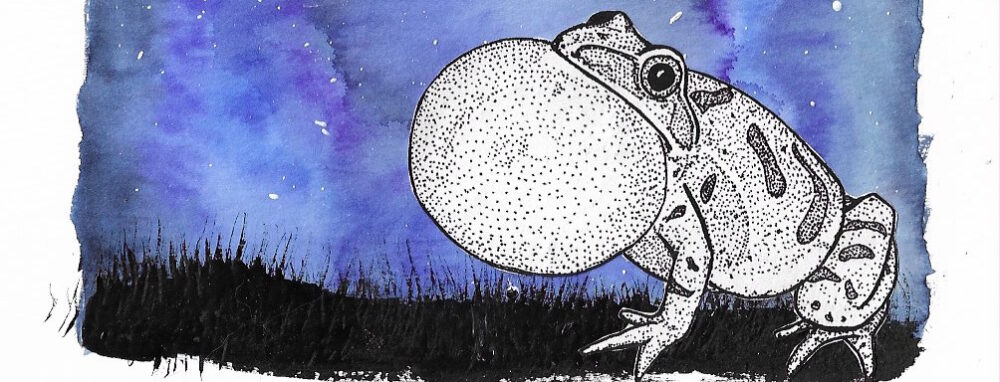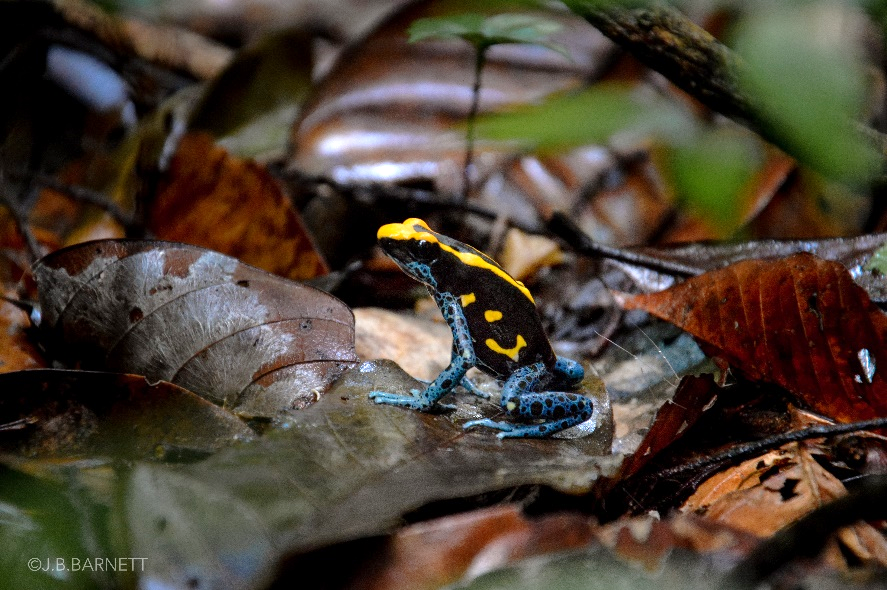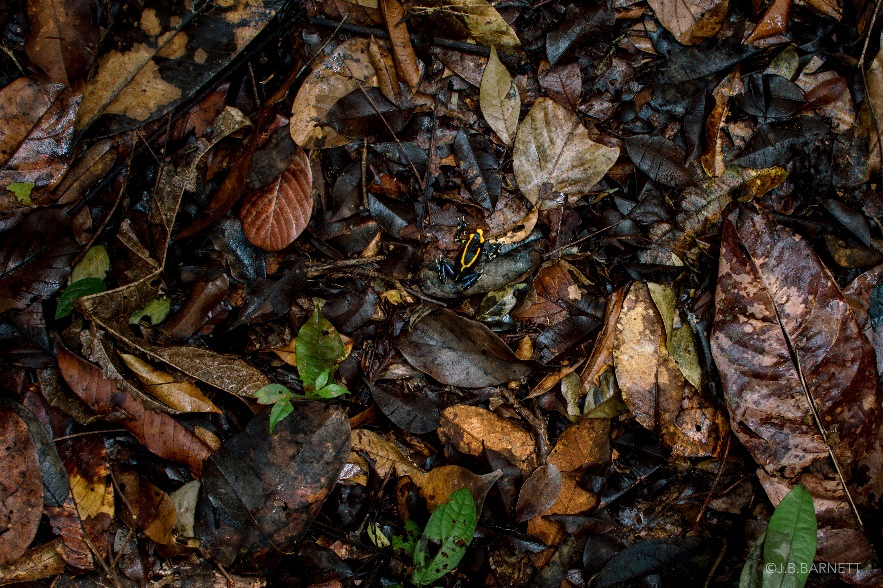By Sarah Clarke
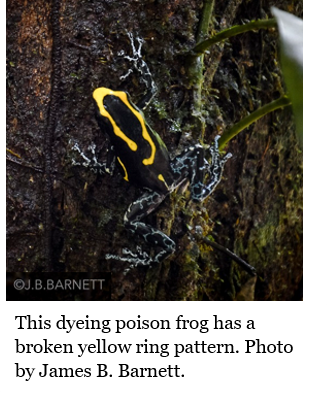
Bright colors may be eye-catching but keep your distance! These are warning colors. Dendrobates tinctorius, also known as the dyeing poison frog, lives across the Guiana Shield rainforests of South America and indicates its toxicity through its bright yellow ring that can either be a broken or joined pattern. These warning colors and toxic defenses deter predation, but these frogs are not home-free. The dyeing poison frog is still subject to predation by unexperienced or specialized predators – primarily bird and snake species. However, it has another defense strategy up its sleeve. When viewed from a distance, its bright colors act as camouflage.
So how does this seemingly contradictory concept work? Typically, warning colorations have symmetrical patterns that are uniform among individuals so that predators can more easily recognize and avoid eating these species. The dyeing poison frog strays from this norm by having asymmetric and variable yellow ring patterns which are more characteristic of concealment strategies.
Previous research has mostly speculated on the potential for camouflage in brightly colored species with few studies actually illustrating this. James B. Barnett began the task of tackling this concept by pursuing his PhD and observing such coloration in caterpillars and moths. However, his interest in amphibians ultimately led him to apply for a grant to study distance and color-based defense strategies in dyeing poison frogs. He and his colleagues tested detectability at different viewing distances via computational models of avian, snake, mammal, and human sight on images of dyeing poison frogs. Their results suggested that at close range these frogs are easily detectable but become more difficult to see as the viewing distance increases.
To test these
results in a more realistic setting, they placed model frogs on different
backgrounds in the French Guianan rainforest to observe how avian predators
would react. The yellow and black frogs (normal coloration) were attacked significantly
less on the natural and printed leaf litter backgrounds, indicating that dyed
poison frog survival appears to be dependent on certain background
characteristics of the rainforest floor. Even humans were tricked by the
camouflage ability of these frogs! During the screen-based detection
experiment, people took longer to find the real frogs than frogs with altered
color patterns at the same distance. These findings suggest that dyeing poison
frogs use a specific ratio and distribution of coloration that allows for
camouflage at a distance.
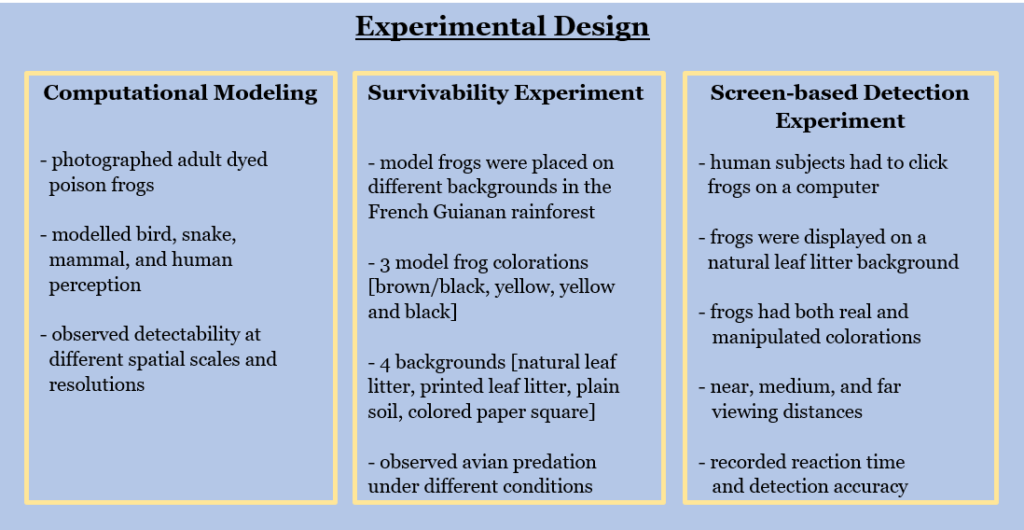
Bottom Line: This study shows that dyeing poison frogs have two primary defense strategies that are dependent on distance. At a close range their bright colors are easily detectible and effective as warning signals. At a distance their bright, asymmetrical patterns act as camouflage by blending with their background. This allows for two highly effective defense strategies against predation – warning coloration and camouflage.
Who Cares: Evidence for distance-dependent camouflage in species with bright, warning colors is limited, making these findings particularly fascinating and novel. While these findings may not have any conservation implications, they do influence the way we think about the evolution of defense strategies and coloration. Many species with warning coloration rely purely on their toxicity or mimicry of other toxic species to avoid predation. However, the dyeing poison frog has interestingly evolved a second and surprising way to avoid predation, and it is a mystery why this species has done so. Sexual selection further complicates this puzzle as females choose which males to mate with based off desirable qualities.
What’s Next: As of right now it is still unknown how the role of movement, varying habitats, lighting, and distance affect the visual acuity of predators and the effectiveness of camouflage. Further research on distant-dependent coloration is sure to follow as Barnett says, “the extent that it actually works needs further study. If you go far enough away from anything it’s going to eventually blend into the background enough that you wouldn’t be able to see it.” The distance at which camouflage is effective and the threshold at which warning colors switch to camouflage has yet to be determined. “I would like to see to what extent [warning-colored] species are doing this,” Barnett says, “as some of the work I’ve been doing since suggest that a lot of species aren’t doing this.” Specifically, some other species of poison dart frogs do not have distance-dependent camouflage patterns, meaning there must be some underlying reason why the dyeing poison frog is different. Who knew a tiny frog could raise so many questions?
Citation: Barnett, J., Michalis, C., Scott-Samuel, N., & Cuthill, I. (2018). Distance-dependent defensive coloration in the poison frog Dendrobates tinctorius, Dendrobatidae. Proceedings of the National Academy of Sciences of the United States of America, 115(25), 6416-6421.
